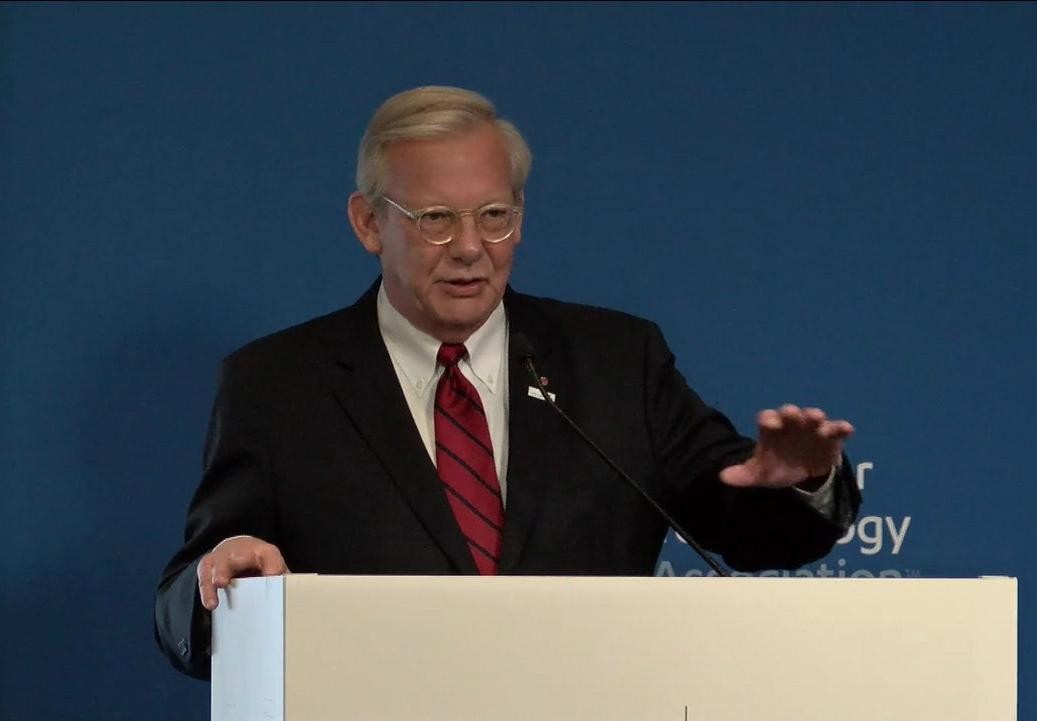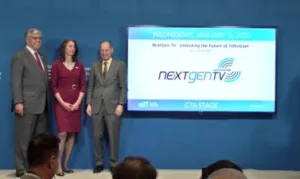“Nextgen TV, powered by ATSC 3.0” was one of the key technologies highlighted at this year’s CES consumer technology show in Las Vegas. The first U.S. consumer receivers with integrated Nextgen TV capabilities were announced, highlighting the key consumer benefits of the new system.

The IEEE International Conference on Consumer Electronics hosted a Nextgen TV session led by ATSC President Madeleine Noland and including representatives from Nextgen TV manufacturers LG Electronics, Samsung and Sony. The ICCE Special Session – “U.S. Launch of ATSC 3.0 Nextgen TV” was moderated by ATSC Board member Brian Markwalter, Senior VP, Consumer Technology Association.
Speaking at the ATSC exhibit, ATSC President Madeleine Noland said,
“We’ve assembled leaders driving Nextgen TV who will be showcasing the many ways that the Internet Protocol-based ATSC 3.0 standard can deliver a better experience for viewers and new business models for broadcasters. We’re looking forward to showing the latest working models, highlighting results from initial consumer research, and explaining how broadcasting will implement ATSC 3.0 to offer new Nextgen TV services.”
 ATSC President Madeleine Noland describes Nextgen TV product rollouts
ATSC President Madeleine Noland describes Nextgen TV product rollouts
ATSC sponsors Pearl TV and the Phoenix Model Market, Sinclair Broadcast Group and ONE Media, Gaian Solutions, and Sony held special exhibits inside the ATSC booth in Central Hall.
“Developed by hundreds of consumer technology and broadcasting experts across the globe, the ATSC 3.0 suite of standards has the capability to easily deliver 4K Ultra HDTV signals to give viewers access to more 4K content – along with a host of other features comprising Nextgen TV,”
said Noland.
Noland, CTA President and CEO Gary Shapiro, and NAB President and CEO Gordon Smith appeared at the CTA stage in the Las Vegas Convention Center’s Grand Lobby to commemorate the official launch of Nextgen TV products at CES that will support the broadcaster rollout of Nextgen TV services using ATSC 3.0 in 60-plus U.S. markets this year.
 Smith, Noland and Shapiro introduce ATSC Nextgen TV at CES 2020
Smith, Noland and Shapiro introduce ATSC Nextgen TV at CES 2020
“This is a milestone year for Nextgen TV,” said NAB President and CEO Gordon Smith. “Early-adopter consumers with these TVs will benefit from Nextgen TV’s new services being launched by local TV stations across America.”
“Viewers in South Korea have been enjoying 4K video and immersive audio delivered via ATSC 3.0 since 2017 and a number of U.S. broadcasters are already on-the-air with Nextgen TV,”
Noland explained.
“Many more channels in the U.S. are expected to sign on as the spectrum repack is completed and stations work cooperatively to launch this revolutionary new service while also preserving current digital TV broadcasts. With a focus on the Top 40 Nielsen markets and more than 20 additional cities, Nextgen TV is expected to reach more than 70 percent of the U.S. population over the next year.”
“CES is just the beginning of Nextgen TV for the consumer technology industry,” she added. “And I know we will be back next year with even more stations on the air offering a growing list of new Nextgen TV features and welcoming news of even more receivers to be introduced for viewers.”
ATSC 3.0 was also spotlighted during an official CES session, “What Nextgen TV Means for Tech,” at the Venetian Convention Center, where a discussion panel included representatives from Pearl TV, Samsung, LG Electronics, NAB and ATSC.
ATSC Applications Showcased
Pearl TV and broadcasters who are part of the Phoenix Model Market demonstrated the new Nextgen TV Application Framework that supports program guide capabilities to give consumers a clear view of what’s available with Nextgen TV on each channel. Dolby offered a demonstration of Voice Boost, which boosts dialogue over background noise and normalizes the audio levels with Nextgen TV. Broadcasters are planning the immediate availability of the Dolby technology, which tested high with consumers in recent research conducted in Phoenix by Magid, which research also shows strong appeal for the Nextgen TV technology on the whole.
Sinclair Broadcast Group and ONE Media provided live Nextgen TV demonstrations across the CES show floor with signals from KSNV-TV, the Sinclair NBC Las Vegas station. Using an LG OLED TV, Sinclair and ONE Media demonstrated the first home over-the-air (OTA) and over-the-top (OTT) converged application to enable switching between broadcast and broadband-delivered channels.
Gaian Solutions showcased an “AI & Data Lake powered Nextgen TV Broadcast Platform as a service,” that provides business management functions, Ad-tech, data analytics, app designer tools and AI agents for rapid service curation and spectrum monetization. The demo integrated a broadcast control system, a full-stack receiver solution, and cloud-based microservices.
Gaian also showed its “3 in 1” service that enables broadcasters to immediately begin offering Nextgen TV services with low-cost modular receivers and low capital investment by using the existing ATSC 1.0 infrastructure.
LG Introduces ATSC 3.0-Enabled OLED TVs
The first U.S. consumer television receivers equipped with Nextgen TV capabilities are coming to retail stores later this year, with TV manufacturers LG Electronics, Samsung and Sony launching 20 ATSC 3.0-enabled TV models. The introductions are timed to support the initial nationwide rollout of Nextgen TV service, powered by the ATSC 3.0 broadcasting standard, planned for more than 60 markets across the U.S.
 John Taylor, Senior Vice President of Public Affairs and Communications for LG Electronics US, at CES 2020
John Taylor, Senior Vice President of Public Affairs and Communications for LG Electronics US, at CES 2020
LG Electronics (LG), co-developer of the ATSC 3.0 next-generation television standard, is ushering in Nextgen TV with the introduction of six advanced new LG OLED TV models equipped to receive new services with enhanced content, pictures and sound.
The six 2020 LG OLED models earning the Nextgen TV logo from the Consumer Technology Association are: the 55-, 65- and 77-inch class GX Gallery Series 4K Ultra HD models, the 65-inch class WX Wallpaper 4K model and 77- and 88-inch class ZX Real 8K models.
The minimalist Gallery Series takes features an ultra-thin form factor that hangs on the wall like a piece of art, while the razor-thin 65OLEDWX Wallpaper TV includes a high-performance Dolby Atmos soundbar for immersive audio. The 2020 LG OLED ZX Real 8K models, delivering four times more detail than 4K TV and 16 times more than HDTV, exceed CTA’s strict requirements related to the official industry definition for 8K Ultra HD TVs.
Along with LG’s third-generation ATSC 3.0 receiver/demodulator, the LG OLED Nextgen TVs include the new ?9 (Alpha 9) Gen 3 AI Processor that leverages upgraded processing power and artificial intelligence to further enhance picture quality and enable specialized features for movies, games and sports. Combining OLED’s self-emitting pixel technology and perfect blacks with support for Dolby Vision IQ and the UHD Alliance’s new Filmmaker Mode,™ 2020 LG OLED TVs bring the cinema into the living room.
Core technologies developed by LG and its U.S. R&D lab Zenith are included in the majority of the ATSC 3.0 Physical Layer Standard. With thousands of related patented inventions, LG contributed to all layers of the ATSC 3.0 standard, including the A/322 transmission system standard and A/330 link-layer protocol standard.
Samsung Electronics Adds Nextgen TV to 2020 QLED 8K Line-up
Samsung Electronics announced at CES that its upcoming 2020 QLED 8K television lineup will offer ATSC 3.0 tuners. Samsung QLED 8K owners will be able to play back 4K broadcasts and content when the signals are transmitted.
Hyogun Lee, EVP of Samsung’s Visual Display Business said
“Samsung is constantly transforming the technology we put in front of our consumers to give them the ultimate home entertainment experience, so leading this endeavor was a natural step. Nextgen TV powered by ATSC 3.0 enhances the at-home viewing experience for our 2020 QLED 8K owners and beyond. We’re excited to see how the standard steers our broadcast partners into developing content and experiences for our 8K ecosystem. We are just beginning to scratch the surface and are excited about the full potential enabled by ATSC 3.0.”
Samsung has been involved in development efforts around high-resolution broadcast for years. The company has also been working with Pearl TV and the National Association of Broadcasters (NAB) on testing new features and broadcasting experimental transmissions, across many industry events and collaborations.
Sony NextGen TV Model Debuts At CES
Sony announced at CES its new X900H 4K LED TV model, which is the first from the company that is NextGen TV-compatible. The X900H will come in 55-, 65-, 75- and 85-inch models, all of which will work with NextGen TV technology (following a software update), while also offering 4K 120fps LED picture quality.
This and other new models also feature Ambient Optimization, a technology that optimizes picture and sound quality based on the consumer’s environment. Additional features include Dolby Vision and Dolby Atmos support, acoustic multi-audio with X-Balanced speaker, a diamond cut bezel, a Triluminos display, an ability to work with Google Home and Amazon Alexa devices and connection to most devices, including Apple AirPlay 2 and HomeKit.
Sony will announce pricing and retail availability for this and other new TV models in spring 2020.
WiPro showcases ATSC solutions at CES
At CES 2020, software developer Wipro demonstrated their next-generation Content Delivery system. Using a combination of 5G and ATSC 3.0, 4K broadcast content can be delivered using their ATSC 3.0 stack, for STBs, Mobile Devices, and Auto Infotainment devices. demonstrating a convergence of technologies, content traffic can be offloaded from 5G broadband by using ATSC-3 broadcast spectrum.
All photos courtesy of ATSC
— agc

